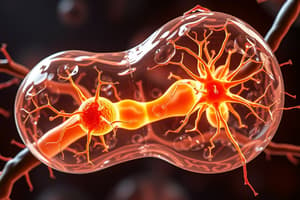Podcast
Questions and Answers
What is the unit for the amount of energy needed to raise the temperature of 1 gram of water 1 degree Celsius?
What is the unit for the amount of energy needed to raise the temperature of 1 gram of water 1 degree Celsius?
calorie
Where is ATP produced in a cell?
Where is ATP produced in a cell?
mitochondria
What is the fluid-filled space enclosed by the inner membrane of a mitochondrion?
What is the fluid-filled space enclosed by the inner membrane of a mitochondrion?
matrix
The folded cristae in a mitochondrion increase the surface area for energy production.
The folded cristae in a mitochondrion increase the surface area for energy production.
What is the first process in both aerobic and anaerobic cellular respiration?
What is the first process in both aerobic and anaerobic cellular respiration?
In which part of the cell does glycolysis occur?
In which part of the cell does glycolysis occur?
What type of process is glycolysis?
What type of process is glycolysis?
What are the two molecules of glucose broken down into during glycolysis?
What are the two molecules of glucose broken down into during glycolysis?
What molecule carries high-energy electrons to the ETC?
What molecule carries high-energy electrons to the ETC?
What is the net total of ATP produced in glycolysis?
What is the net total of ATP produced in glycolysis?
Where does aerobic respiration occur in the cell?
Where does aerobic respiration occur in the cell?
What is the balanced equation for aerobic respiration?
What is the balanced equation for aerobic respiration?
What are the two processes involved in aerobic respiration that occur after glycolysis?
What are the two processes involved in aerobic respiration that occur after glycolysis?
Where does the Krebs cycle occur?
Where does the Krebs cycle occur?
What is pyruvic acid broken down into during the Krebs cycle?
What is pyruvic acid broken down into during the Krebs cycle?
What is produced in the Krebs cycle besides ATP?
What is produced in the Krebs cycle besides ATP?
What is the net total of ATP produced by the Krebs cycle?
What is the net total of ATP produced by the Krebs cycle?
What do NADH and FADH2 carry?
What do NADH and FADH2 carry?
What is the final step in aerobic respiration?
What is the final step in aerobic respiration?
Where does the electron transport chain occur?
Where does the electron transport chain occur?
What is the final electron acceptor in the ETC?
What is the final electron acceptor in the ETC?
What is the net total of ATP produced by the electron transport chain?
What is the net total of ATP produced by the electron transport chain?
What happens when there is no oxygen available for aerobic respiration?
What happens when there is no oxygen available for aerobic respiration?
What are the two types of fermentation?
What are the two types of fermentation?
What is pyruvic acid converted into during lactic acid fermentation?
What is pyruvic acid converted into during lactic acid fermentation?
What organisms produce dairy products with lactic acid?
What organisms produce dairy products with lactic acid?
What are the two products produced during alcoholic fermentation?
What are the two products produced during alcoholic fermentation?
What is the net total of ATP produced during anaerobic respiration?
What is the net total of ATP produced during anaerobic respiration?
Photosynthesis and cellular respiration are independent processes that do not rely on each other.
Photosynthesis and cellular respiration are independent processes that do not rely on each other.
What is the primary product of photosynthesis?
What is the primary product of photosynthesis?
What is the primary product of cellular respiration?
What is the primary product of cellular respiration?
How is ATP used in cells?
How is ATP used in cells?
Flashcards
Cellular Respiration
Cellular Respiration
The process cells use to break down food (like glucose) and release energy stored within it.
ATP
ATP
Adenosine triphosphate; the main energy currency of the cell.
Calorie
Calorie
Unit to measure the energy stored in food.
Mitochondria
Mitochondria
Signup and view all the flashcards
Inner Membrane (Mitochondria)
Inner Membrane (Mitochondria)
Signup and view all the flashcards
Cristae
Cristae
Signup and view all the flashcards
Glycolysis
Glycolysis
Signup and view all the flashcards
Cytoplasm
Cytoplasm
Signup and view all the flashcards
Anaerobic
Anaerobic
Signup and view all the flashcards
Aerobic
Aerobic
Signup and view all the flashcards
Pyruvic Acid
Pyruvic Acid
Signup and view all the flashcards
Krebs Cycle
Krebs Cycle
Signup and view all the flashcards
Electron Transport Chain (ETC)
Electron Transport Chain (ETC)
Signup and view all the flashcards
NADH and FADH2
NADH and FADH2
Signup and view all the flashcards
Lactic Acid Fermentation
Lactic Acid Fermentation
Signup and view all the flashcards
Alcoholic Fermentation
Alcoholic Fermentation
Signup and view all the flashcards
Glucose
Glucose
Signup and view all the flashcards
Oxygen
Oxygen
Signup and view all the flashcards
Carbon Dioxide
Carbon Dioxide
Signup and view all the flashcards
Water
Water
Signup and view all the flashcards
Matrix (mitochondria)
Matrix (mitochondria)
Signup and view all the flashcards
Acetyl CoA
Acetyl CoA
Signup and view all the flashcards
Fermentation
Fermentation
Signup and view all the flashcards
Food
Food
Signup and view all the flashcards
Study Notes
Cellular Respiration Overview
- Cellular respiration is the process that releases energy from food
- The overall equation is Glucose + Oxygen → Carbon dioxide + Water + ATP!
- The goal of this process is to make ATP
- Food is broken down into two ways:
- Anaerobic cellular respiration (also called fermentation)
- Aerobic cellular respiration (or just cellular respiration)
- The first step in either method is Glycolysis
Chemical Energy and Food
- The energy source is food. Food is used to make ATP
- A "calorie" is the unit for the amount of energy needed to raise the temperature of 1 gram of water 1 degree Celsius
- One calorie provides approximately 9000 ATP's
- Food is used to restore ATP, which is lost as heat or waste, or stored for later use.
Location of ATP Production
- ATP is produced in the mitochondria
Mitochondria Structure
- Mitochondria are double membrane-bound organelles
- The inner membrane encloses a fluid-filled matrix
- Cristae (folds) are inside the matrix
- These folds increase the surface area of the membrane
- Mitochondria contain small circular DNA
Cellular Respiration Processes
-
Glycolysis :
- Occurs in the cytoplasm of the cell
- An anaerobic process
- Glucose is broken down into 2 molecules of pyruvic acid
- NADH is produced and carries high-energy electrons to the ETC
- Produces a total of 2 ATP
-
Aerobic Respiration:
- Location: Mitochondria
- Aerobic process which means it requires oxygen to proceed
- Process used by cells to get the most energy out of food molecules
- Balanced equation is : 6O₂ + C₆H₁₂O₆ →→ 6CO₂ + 6H₂O + 36 ATP
- Two Processes involved in aerobic cellular respiration:
- Krebs Cycle:
- Location: Matrix of mitochondria
- Pyruvic acid breaks down into Acetyl CoA
- Carbon Dioxide (CO2) is Released
- Electron carriers FADH2 and NADH are made
- About 2 ATP made in the process. - Electron Transport Chain (ETC): - Location Cristae (inner membranes) of mitochondria - Electron carriers release high energy electrons to carrier membrane proteins - H+ ions move through ATP Synthase to make ATP - Oxygen is the final electron acceptor combining with H+ ions (creating water) - Approximately 32 ATP produced in this stage
-
Anaerobic Respiration (Fermentation):
- Occurs in the cytoplasm of the cell
- Anaerobic process
- Starts with Glycolysis
- Two types of fermentation exist - Lactic acid fermentation (lactic acid is produced) - often used by Bacteria to make dairy products - Alcoholic fermentation (Carbon Dioxide and ethanol are produced) - used by yeast
-
The total ATP from anaerobic fermentation is 2 ATP.
Photosynthesis and Cellular Respiration Relationship
- Photosynthesis creates energy and cellular respiration releases energy.
- Photosynthesis produces glucose and oxygen using sunlight
- Cellular respiration breaks down glucose and oxygen to release energy in form of ATP.
Studying That Suits You
Use AI to generate personalized quizzes and flashcards to suit your learning preferences.




